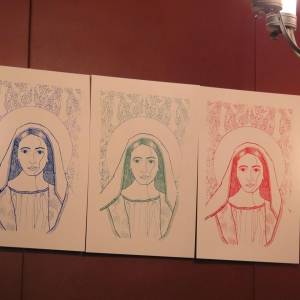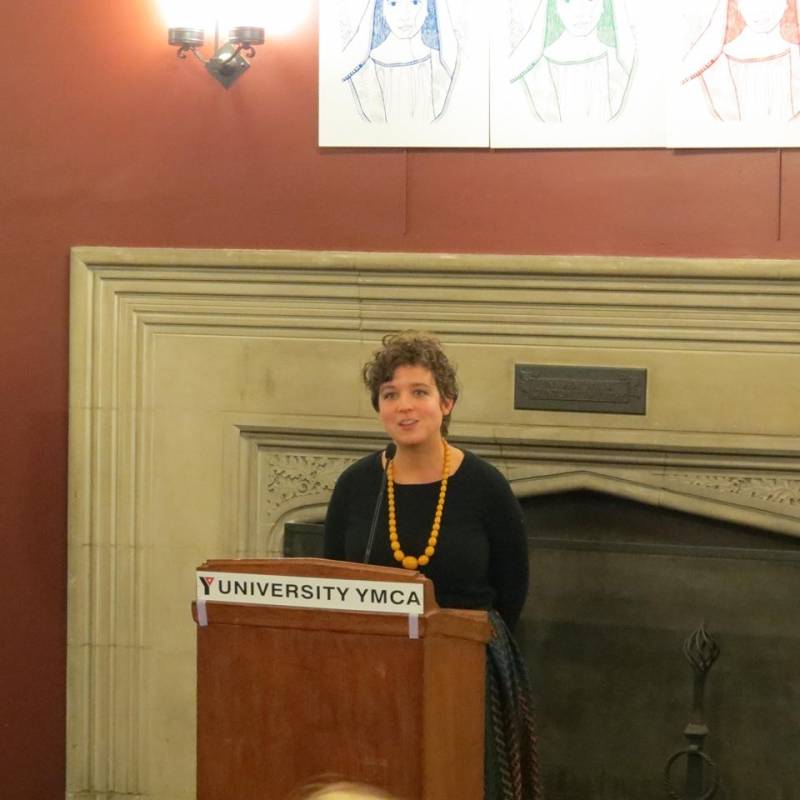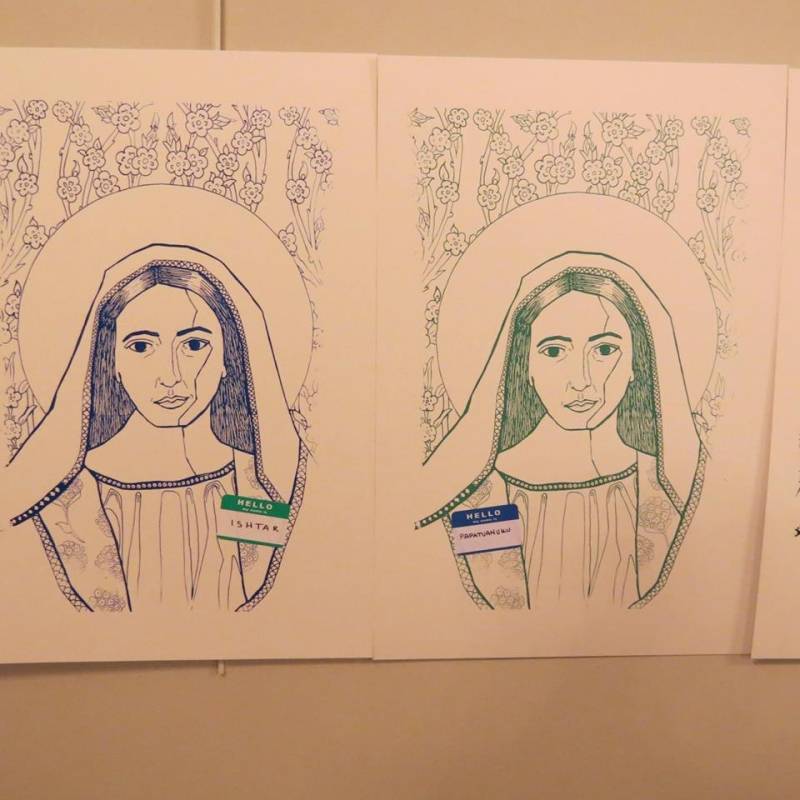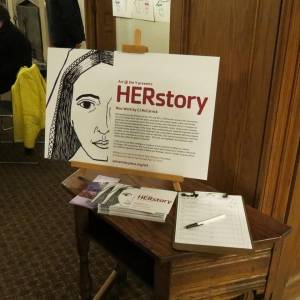The University YMCA’s Art @ the Y program began in fall 2010 as a way to get the Champaign-Urbana area to engage in, among other topics: social justice, faith, cultural and international understanding, as well as environmental activism.
 CJ McCarrick, an MFA candidate in Sculpture at the University of Illinois, contributed to this mission with “HERstory,” her first solo exhibition. HERstory uses spiritual feminism to emphasize similarities between different cultures and religions, specifically through images of the Virgin Mary and how they influence women in influential ways throughout the global community.
CJ McCarrick, an MFA candidate in Sculpture at the University of Illinois, contributed to this mission with “HERstory,” her first solo exhibition. HERstory uses spiritual feminism to emphasize similarities between different cultures and religions, specifically through images of the Virgin Mary and how they influence women in influential ways throughout the global community.
“The work stems out of my practice,” McCarrick told me. “I make work about this kind of subject matter, and that really fit well because…that space is about…community and inclusion.”
An opening reception for McCarrick’s series was held on Friday, February 27. Ann Rasmus, coordinator of Art @ the Y called the vent “ a large gathering…and a steady stream of visitors since.”
“The exhibition has been received very well,” said Rasmus. “The work is new and exciting, and people seem really interested.”
“The Y is a really great place to show art,” said McCarrick. “I think the broadness (of ‘HERstory’) reflects this community because… the University pulls in people from all different places and all different ideas, and people that go to the Y are coming from so many different backgrounds. It’s such a space of general acceptance and openness and welcome…so I don’t want the work to be exclusive.”

Although McCarrick, a feminist, has not worked closely with spiritual feminism before, she has worked with religion in many of her past works. “I have feminist interests, and my work has been about religion and interconnectivity with religion. I work with pointing out flaws and positives and making aware, through the work, the complexities—the way that these things are really complex in how they’re intersected and how they bleed out into our culture and our society.”
Spiritual feminism is something of the past, according to McCarrick. The “HERstory” screen-prints of the Virgin Mary were inspired by specific feminist readings that focused on “the great cosmic mother” and McCarrick’s reaction to them, which was “This is absurd!” But, as McCarrick explains, “it’s so absurd because I haven’t seen it yet. I haven’t read about it yet, and it’s not present in contemporary feminism.”
Perhaps this is because the field wants to be taken more seriously, but McCarrick asks, “Do we want that to be the way it is? Or do we need to be…maybe a little bit more spiritual or a little more emotional about it?”
Here’s where I interject, saying that I had never heard about spiritual feminism. “Right?!” McCarrick exclaims. “But you think about…hippies. They’re spiritual, getting back to these quote-unquote roots of the mother and the earth, so I wanted to pull that out again and reference that in the way that I depicted one of the last female icons that the big religions around the world have.”

McCarrick’s work is usually three-dimensional, with sculptures and installations; “HERstory,” however, is based on photo-copy and screen-print art. “Screen printing has this connection in dispersing information, which brings it back to ’80s feminism and subway pamphlets…dispersing information quickly and cheaply.”
“HERstory” is meant to “pose questions and pose ideas, like, ‘Why are contemporary religious groups or practices…so exclusionary to women when we have this broad history, broad time, and broad cultural examples of women as idols or as goddess or as spirit or saint? Why is it so limited now?’” As McCarrick points out, the “Big 3” religions (Christianity, Judaism, and Islam) “are very exclusionary, and you also see a lot of sexism stemming from that. In the case of the Virgin, she’s inactive. Things are done upon her: she is chosen, she is impregnated, she is the mother of someone who does something, so she loses her authority.”
“I was raised Catholic,” she continued. “I am no longer a Catholic. I just felt frustrated, I felt misrepresented…and I felt disempowered, and I found that really problematic.”
“I fully imagine that the Mary that existed years and years and years ago was a ranking member in her community and was an active member in her communities, participated with other women and maybe even, to some extent, participated in a local economy in some way to support the family, to support the people she loved, just like women do all over the world now,” McCarrick said.
The visual simplicity and intellectual and cultural broadness of “HERstory” really has the power to spark much conversation about religion and feminism.
 “Nobody’s talking about it,” McCarrick said. “Even when my work is about it, people are very timid because they don’t want to sound like a religious crazy person. They don’t want to sound like the people that they hear…that are saying things they don’t like to hear. There seems to be this weird lack of religiousness in the Democratic Party: ‘We don’t want to be that, we want to be the opposite of that, so that means don’t talk about it.’”
“Nobody’s talking about it,” McCarrick said. “Even when my work is about it, people are very timid because they don’t want to sound like a religious crazy person. They don’t want to sound like the people that they hear…that are saying things they don’t like to hear. There seems to be this weird lack of religiousness in the Democratic Party: ‘We don’t want to be that, we want to be the opposite of that, so that means don’t talk about it.’”
McCarrick is also currently featured in a show in Ann Arbor called “Re-imaging Gender.” More of her work can be found on her website.
The University Y is located at 1001 S. Wright St. in Champaign. “HERstory,” can be found inside the Murphy Gallery now until Friday, April 10. Gallery hours are Mondays through Thursdays from 9 a.m. to 9 p.m. and Fridays from 9 a.m. to 5 p.m. The exhibition, as any Art @ the Y exhibition, is free and open to the public.
Pictures provided by the University Y.








